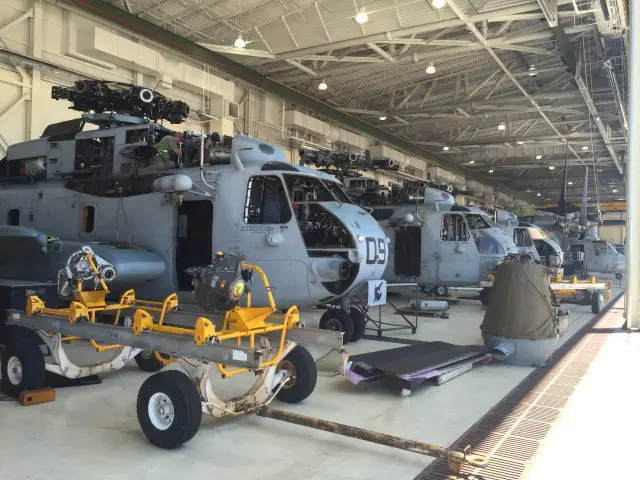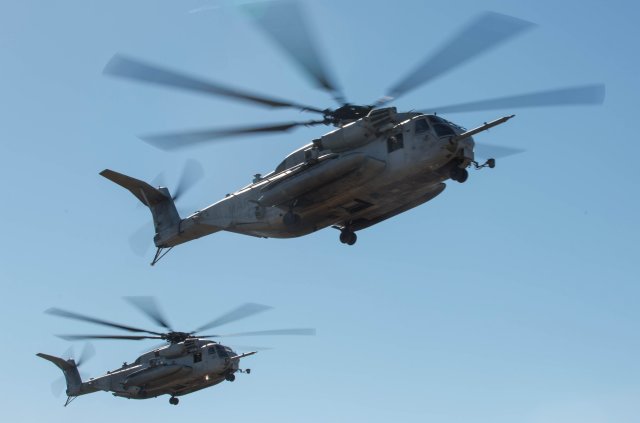Breaking news
US Marine Corps launched full reset of its 147 CH-53E Super Stallion rotorcraft.
| a | |||||
|
|
|||||
|
World Aviation Defense & Security News - United States
|
|||||
|
|
|||||
|
US Marine Corps launched full reset of its 147 CH-53E Super Stallion rotorcraft
|
|||||
|
U.S. Marine Corps has begun a full reset of its CH-53E Super Stallion heavy lift helicopters, an effort aimed at significantly increasing the number of operationally fit aircraft and addressing systemic issues, which in recent years drove the platform’s readiness level to unsustainable depths, the Naval Air Systems Command announced on August 10.
|
|||||
|
|
|||||
 The next five CH-53Es have begun the reset process with three pictured here in various stages at Marine Corps Air Station New River, N.C. The other two are at Marine Corps Air Station Miramar, Calif The next five CH-53Es have begun the reset process with three pictured here in various stages at Marine Corps Air Station New River, N.C. The other two are at Marine Corps Air Station Miramar, Calif(Credit: NAVAIR) |
|||||
|
|
|||||
|
The issue first came to light following the January 2014 crash of an MH-53E Sea Dragon-the Navy’s version of the aircraft-off the coast of Norfolk, Virginia, during a routine training exercise. Three of the five Sailors onboard were killed. The subsequent investigation determined that electrical wires inside the aircraft had chafed against and breached a fuel line, sparking a fire that flooded the cabin and cockpit with thick smoke. The crash prompted an inspection of all CH/MH-53s for signs of chaffing between cabin fuel tubes and electrical wiring.
“What was discovered was that the material condition of the aircraft, both the CH-53E and the MH-53E, was degraded,” said Col. Hank Vanderborght, program manager for the H-53 Heavy Lift Helicopters Program Office (PMA-261) at Naval Air Systems Command. “Those helicopters have been around since the early 80s, so 30-plus years, and we’d been at war [on terrorism] for the last 15 years, so the machines had been used pretty hard.” The CH-53E’s report, titled the Super Stallion Independent Readiness Review (SSIRR), “had a lot of findings that were causal to this low readiness,” Vanderborght said. “Part of it was material condition of the aircraft, supply system agility, and issues with maintenance publications, support equipment and training. There were a lot of different issues that compounded the problem.” In response to the SSIRR’s findings, the Corps “put together a two-step strategy to attack readiness,” Vanderborght said, the first step being a complete “reset” of all 147 aircraft, a process expected to take three years. “We’re going to put every airframe through an on-average 110-day process of stripping the aircraft down completely, rebuilding it and changing out any high-time components,” he said. The reset validation aircraft was completed in April at Marine Corps Air Station New River, North Carolina, and flew back to the West Coast in June. The next five CH-53Es have begun the process—three at New River and two at Marine Corps Air Station Miramar, California. Vanderborght said the plan is to eventually have 16 aircraft being reset at any given time—seven at both New River and Miramar, and two at Marine Corps Air Station Kaneohe Bay, Hawaii. Though only the validation aircraft has been completed thus far, its results have Vanderborght optimistic about the remaining CH-53Es. After not flying for four years, the validation CH-53E required only 12 days of functional check flights to be deemed operational, a significant reduction from the three to four months of check flights that are typically needed for Super Stallions that spend that much time grounded, Vanderborght said. |
|||||
|
|
|||||
 Two CH-53E Super Stallions fly over a landing zone during section Confined Area Landings board Marine Corps Base Camp Pendleton, Calif., Dec. 2, 2015 Two CH-53E Super Stallions fly over a landing zone during section Confined Area Landings board Marine Corps Base Camp Pendleton, Calif., Dec. 2, 2015(Credit: USMC/Sgt. Lillian Stephens) |
|||||
|
“The reset process it went through did everything right,” he added. “I’ve been around 53s for 22 years, and with the exception of picking up a brand new one from the Sikorsky factory—which doesn’t exist anymore because the line is shut down—the validation CH-53E is the nicest one I’ve ever seen.”
“We only had 30-or-so aircraft up last year,” he said. “We’re in the 50s now, so we’ve rebounded pretty well from a year ago,” he said. The second step involves addressing those remaining “systemic” issues, a preventative step meant to ensure another reset is not needed in the future. “All these things that are needed in order to make sure the maintenance system all works well together, from inaccurate maintenance manuals to support equipment shortfalls and training for maintainers and functional check pilots,” Vanderborght said. “The reset itself is only one piece of the strategy. If we only did the reset and didn’t address all those system issues that got us to low readiness, within five years we’d probably be right back where we are now.” Vanderborght stressed that one aspect that will require particular attention is the training of CH-53E maintainers, most of whom have spent their entire careers in the Marines during a time when the focus has been on quickly turning out aircraft rather than taking the time to digest and learn the systems they’re working on. “We’ve been at war [on terrorism] since 2001, so many of today’s senior maintainers in the Marine Corps joined when our modus operandi has been to make mission at all times. They’ve been taught to maintain airplanes by fixing what’s broken and get it back to the mission,” Vanderborght said. “Before 2001, maintainers would troubleshoot the system and take a long time to understand it, so there was a lot of knowledge developed by on-the-job-training. We’ve kind of lost all that knowledge. I would say the Marines today—not to their fault—are not as knowledgeable about the aircraft as they were prior to the war, Vanderborght said. Put another way, Marine maintainers have operated like a football team without an offseason or training camp in 15 years. “We’re trying to get back to blocking and tackling, the basics,” Vanderborght said. |
|||||
,



















